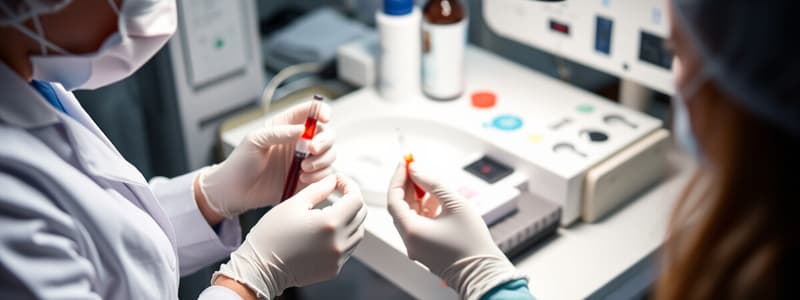Podcast
Questions and Answers
Blood bank tests require the collection of which of the following?
Blood bank tests require the collection of which of the following?
- Green top heparin tubes
- Red top serum tubes
- Lavender or pink top EDTA tubes (correct)
- Blue top citrate tubes
For FUO, cultures should be collected one right after another from different sites.
For FUO, cultures should be collected one right after another from different sites.
True (A)
The same methods for blood culture skin antisepsis for adults apply to pediatric patients unless the antiseptic is tincture or iodine.
The same methods for blood culture skin antisepsis for adults apply to pediatric patients unless the antiseptic is tincture or iodine.
True (A)
To minimize the risk of contamination by skin flora, the collection sites require a ________________________________.
To minimize the risk of contamination by skin flora, the collection sites require a ________________________________.
When a test for _____ is ordered, the blood specimen must be sent for testing immediately or collected in a special stabilizing reagent.
When a test for _____ is ordered, the blood specimen must be sent for testing immediately or collected in a special stabilizing reagent.
When a trace element test is ordered, it is best to draw it by itself if using a needle/tube assembly.
When a trace element test is ordered, it is best to draw it by itself if using a needle/tube assembly.
Coagulation specimens drawn through VADs require a discard volume of blood that is ____ times the dead space volume of the tubing.
Coagulation specimens drawn through VADs require a discard volume of blood that is ____ times the dead space volume of the tubing.
A GTT patient is not allowed to__________________.
A GTT patient is not allowed to__________________.
__________ samples are preferred for paternity testing; however, buccal swabs are increasingly being used.
__________ samples are preferred for paternity testing; however, buccal swabs are increasingly being used.
Drug screening tests are typically performed on ________ rather than blood.
Drug screening tests are typically performed on ________ rather than blood.
Flashcards
Blood culture collection sites
Blood culture collection sites
Require a 30-60 second friction scrub to minimize skin flora contamination.
FUO cultures
FUO cultures
Should be collected from different sites immediately to catch pathogens effectively.
Pediatric blood cultures
Pediatric blood cultures
Use the same methods as adults (except tincture/iodine antiseptics).
RNA testing
RNA testing
Signup and view all the flashcards
Trace element tests
Trace element tests
Signup and view all the flashcards
VAD coagulation specimens
VAD coagulation specimens
Signup and view all the flashcards
GTT patient restrictions
GTT patient restrictions
Signup and view all the flashcards
Paternity testing samples
Paternity testing samples
Signup and view all the flashcards
Drug screening samples
Drug screening samples
Signup and view all the flashcards
EDTA tubes
EDTA tubes
Signup and view all the flashcards
Study Notes
Blood Banking and Specimen Collection
- Blood bank tests typically require lavender or pink top EDTA tubes for collection.
- For fever of unknown origin (FUO), two or three cultures should be collected consecutively from different sites to ensure accurate results.
Pediatric Considerations
- The same antiseptic methods for blood culture skin preparation used for adults can also apply to pediatric patients, except when using tincture or iodine as antiseptic.
Skin Antisepsis Techniques
- To reduce contamination risks from skin flora when collecting specimens, sites should undergo a 30 to 60 second friction scrub to effectively reach bacteria beneath dead skin cells.
RNA Testing
- Blood specimens for RNA tests must be sent for testing immediately or collected in a special stabilizing reagent to preserve RNA integrity.
Trace Element Testing
- For trace element tests, it is recommended to draw the specimen by itself using a needle and tube assembly to prevent contamination from other tests.
Coagulation Specimens
- Coagulation specimens drawn through vascular access devices (VADs) require discarding blood that is six times the dead space volume of the tubing, roughly 5 mL, to ensure accurate readings.
Glucose Tolerance Test (GTT) Protocol
- During a Glucose Tolerance Test (GTT), the patient must refrain from drinking beverages or chewing gum, as these activities can activate the digestive process and affect test results.
Paternity Testing Samples
- Blood samples are preferred for paternity testing; however, buccal swabs are increasingly utilized due to their convenience and effectiveness.
Drug Screening Preferences
- Drug screening tests are primarily conducted on urine rather than blood, as urine is more accessible for collection and can detect a wider variety of drugs and their metabolites over a longer period.
Studying That Suits You
Use AI to generate personalized quizzes and flashcards to suit your learning preferences.




